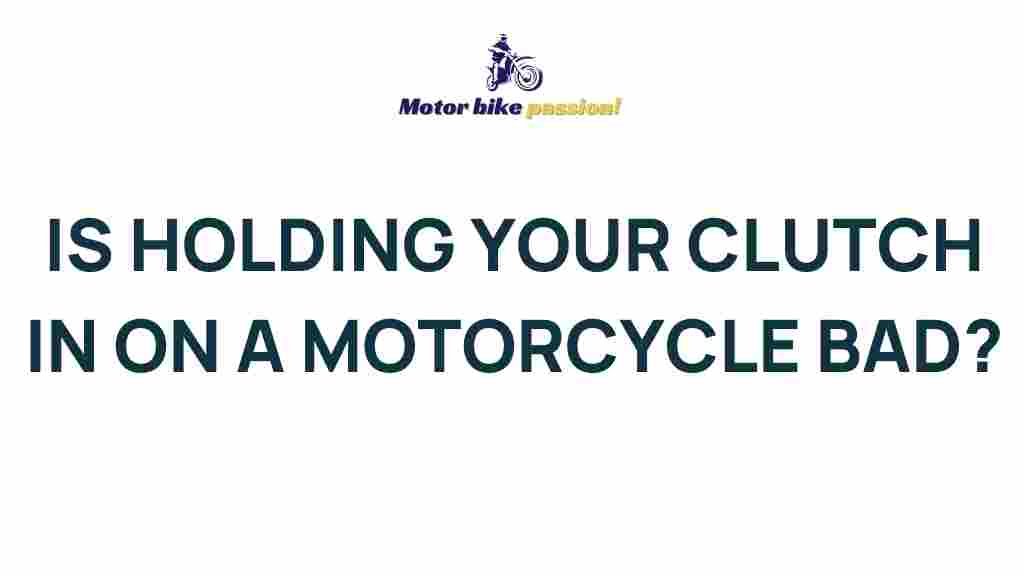The Hidden Dangers of Clutch Habits on Your Motorcycle
Motorcycling is a thrilling experience that combines freedom, adventure, and skill. However, with great thrill comes great responsibility. One of the most critical components of riding safely is mastering your clutch habits. Many riders unknowingly develop habits that can pose significant dangers to their safety and the longevity of their motorcycle. In this article, we’ll explore the hidden dangers of clutch habits, the importance of proper riding techniques, and essential maintenance tips to ensure your safety on the road.
Understanding the Clutch and Its Role in Riding
The clutch is a vital part of your motorcycle’s transmission system, allowing you to disengage the engine from the rear wheel when shifting gears. Understanding how to use the clutch effectively can enhance your riding experience and improve safety. Here are some key functions of the clutch:
- Gear Shifting: The clutch enables smooth transitions between gears.
- Speed Control: It helps in controlling your speed, especially in stop-and-go traffic.
- Engine Engagement: The clutch allows you to engage and disengage the engine as needed.
Common Clutch Habits That Can Be Dangerous
While practicing good clutch control is essential, many riders fall into bad habits that can lead to dangerous situations. Here are some common clutch habits that can jeopardize your safety:
- Riding with the Clutch Pulled In: Many riders develop the habit of riding with the clutch lever pulled in, which can lead to overheating and premature wear of the clutch components.
- Partial Clutch Engagement: Keeping the clutch partially engaged while riding can result in poor power delivery and increased strain on the clutch.
- Improper Gear Shifting: Shifting gears without fully engaging or disengaging the clutch can lead to grinding and damage to the transmission.
- Ignoring Clutch Maintenance: Neglecting to check and maintain your clutch system can lead to serious issues, including clutch failure.
Why Clutch Habits Matter: The Dangers of Poor Technique
Bad clutch habits can lead to a range of dangers while riding. Let’s explore some of the potential risks involved:
1. Increased Risk of Accidents
Riders who fail to control their clutch effectively may find themselves in dangerous situations. For instance, if you are unable to downshift quickly due to improper clutch use, you might miss an opportunity to brake or maneuver out of harm’s way.
2. Mechanical Failures
Worn-out clutches are often a result of poor habits. Not only can this lead to costly repairs, but it can also compromise your bike’s performance. A slipping or malfunctioning clutch can leave you stranded on the road, increasing your risk of an accident.
3. Reduced Riding Enjoyment
When you struggle with clutch control, your riding experience suffers. You may feel anxious or uncomfortable, which detracts from the joy of riding. Mastering your clutch technique enhances your confidence and overall enjoyment.
Step-by-Step Guide to Proper Clutch Use
To avoid the dangers associated with bad clutch habits, follow this step-by-step guide to proper clutch use:
1. Learn the Clutch Feel
Before riding, familiarize yourself with the feel of your motorcycle’s clutch lever. Practice pulling it in and releasing it while the bike is stationary. This will help you understand the engagement point and how it affects your bike’s performance.
2. Use the Clutch Fully
Always pull the clutch in fully when shifting gears. This ensures smooth transitions and reduces wear on your transmission. Remember to release the clutch slowly as you apply throttle to avoid jerky movements.
3. Avoid Riding with the Clutch In
Make it a habit to not ride with the clutch pulled in. Instead, fully engage the clutch when necessary and use the throttle to control your speed.
4. Practice Smooth Shifting
To improve your shifting technique, practice smooth gear transitions. Shift up and down without hesitation, ensuring that the clutch is fully engaged or disengaged at all times.
5. Regular Maintenance Checks
Regular maintenance of your motorcycle’s clutch system is crucial. Check the fluid levels, inspect for leaks, and adjust the clutch cable if necessary. Keeping your clutch system in good condition will enhance safety and performance.
Troubleshooting Common Clutch Issues
Even with the best habits, issues can still arise. Here are some troubleshooting tips for common clutch problems:
1. Slipping Clutch
If you notice your bike revving without acceleration, you may have a slipping clutch. This could indicate worn plates or improper adjustment. You may need to:
- Inspect the clutch plates for wear.
- Adjust the clutch cable tension.
- Consult a mechanic if the issue persists.
2. Sticking Clutch
A sticking clutch can make it difficult to shift gears. If you experience this:
- Check for any obstructions or dirt around the clutch lever.
- Ensure that the clutch cable is lubricated and free from kinks.
- Consider replacing the clutch cable if it is frayed or damaged.
3. Hard Clutch Pull
If the clutch lever feels stiff, it may indicate a need for maintenance:
- Check the clutch cable for fraying or damage.
- Lubricate the cable and the pivot points of the lever.
- Inspect the clutch assembly for any signs of wear or damage.
Conclusion: Stay Safe and Enjoy Your Ride
Mastering your clutch habits is essential for safe and enjoyable motorcycling. By understanding the hidden dangers of poor clutch use and implementing proper techniques, you can significantly reduce the risks associated with riding. Always prioritize regular maintenance and be mindful of your habits to ensure your motorcycle remains in excellent condition.
Remember, riding is not just about the destination; it’s about enjoying the journey safely. For more tips on motorcycle maintenance and riding safety, check out this helpful resource. And to learn more about motorcycle gear and safety practices, visit this informative site.
Ride safe, and enjoy every moment on your motorcycle!
This article is in the category Maintenance Tips and created by MotorBikePassion Team
